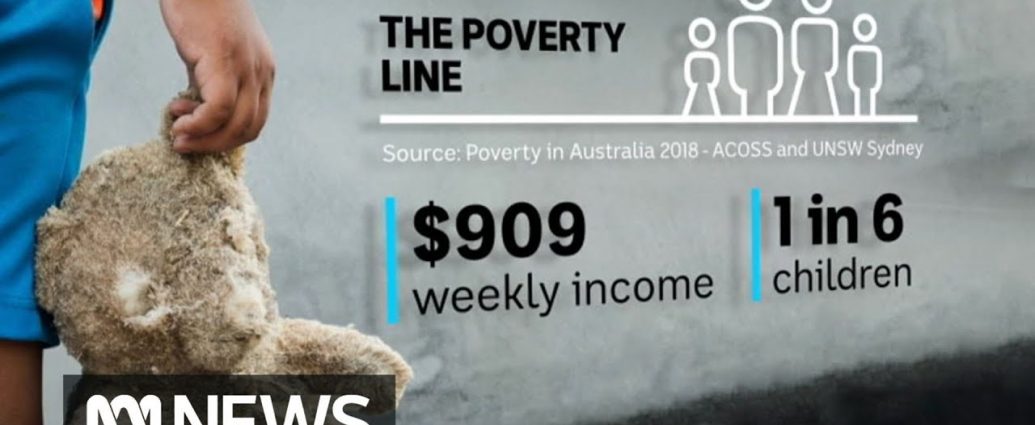Queensland single mother Paulene dreams of the day she can afford everything on her grocery list, but with rent to pay, a young mouth to feed and a casual retail job with uncertain hours, she is worried she never will.
Key points:
- Research shows one-in-five children in Queensland live in poverty
- Advocacy groups are calling on more investment in social housing and income support
- A survey finds only 44 rentals across the country were affordable for a single parent
- “Some weeks you’re just exhausted from surviving,” she said.
Paulene and her 10-year-old daughter, Tabitha, are among nearly 600,000 Queenslanders living in poverty, according to new research released to mark Anti-Poverty Week.
“Nine times out of 10, by the time we get to the end of the week, I’m overdrawn by anywhere between $20 to $50 because the money just isn’t there,” Paulene said.
“It would be so nice to have a bill come in and be able to pay it.”
For Tabitha, it’s hard watching her mum struggle.
“It’s really hard to watch her do all these things and [I] just can’t do anything,” Tabitha said.
“I wish I could actually have money but I can’t because I’m a child.”
Research shows one-in-five children in Queensland live in poverty, with many at risk of homelessness due to a shortage of affordable housing, according to PeakCare executive director Lindsay Wegener.
“That’s simply appalling. We can’t, in a wealthy country like Australia, tolerate that,” Ms Wegener said.
“We need to ensure every family has enough money to cover basics as well as a secure roof over their heads.”
Houses, trees, rooftops, and showing traffic driving on a hilly street in Brisbane.
It’s not always obvious, but around 600,000 Queenslanders are living in poverty, new research shows.(ABC News: Liz Pickering)
Keys to unlocking poverty
Advocacy groups are calling on state and federal governments to invest more in social housing and income support.
Brisbane homelessness charity Micah Projects’ chief executive Karyn Walsh said Federal Rent Assistance was not high enough for families to survive, only covering a third of rent.
“The weekly asking rents for all houses in Brisbane and regional Queensland has increased exponentially during the last financial year,” Ms Walsh said.
“Raising income support above the poverty line and government investment in social housing are the keys to unlocking poverty.”
Data from Anglicare’s rental affordability snapshot surveyed more than 74,000 rentals across the country in March 2021.
Micah Projects chief executive Karyn Walsh says federal assistance is only covering a third of the rent.(ABC News: Baz Ruddick)
It found only 44 were affordable for a single parent with a child over eight years old receiving the single parenting payment.
A spokesperson for federal Social Services Minister Anne Ruston said released a statement.
“This government is providing record support for Australians doing it tough, such as our $50-per-fortnight increase to the rate of JobSeeker and related payments, the single-largest increase in more than 30 years,” the statement said.
“On top of that, we provided $32 billion in emergency support payments to income support recipients during the height of the pandemic.
“Our focus is now firmly on reopening the economy because we know the best form of welfare is a job.”
A departmental spokesperson for the Queensland Department of Communities, Housing and Digital Economy said it was investing billions in social housing.
“As part of this year’s state budget, we committed a $2.9 billion total housing investment, including the establishment of a $1 billion Housing Investment Fund, to underpin the Queensland Housing and Homelessness Action Plan 2021-2025,” the spokesperson said.
“This is the largest concentrated investment in social housing in Queensland’s history.
“The $2.9 billion investment includes $1.9 billion over four years under the Queensland Housing Investment Growth Initiative (QHIGI) to commence 7,400 new social and affordable homes, boost housing supply and increase housing and homelessness support across Queensland.”
In ‘survival mode’
For people like Paulene, it’s not enough to pull her over the poverty line.
Paulene spoke to the ABC in September 2020 about the relief she felt when the JobSeeker payment was doubled as a result of the pandemic.
She said it granted her greater access to the basic necessities most Australians can afford. But that all disappeared when JobSeeker ended in March 2021.
Paulene said JobSeeker allowed her to stock her fridge with fresh food.(ABC News: Chris Gillette)
“There are some weeks where we get towards the end of the week and I realise I don’t have enough petrol to do something.
“I’ll skip meals to make sure the kids eat. Even these days, with foodbanks and things, you can still [find] some weeks there are so many bills to pay and to cover rent.”
She said the increase of $50 every fortnight had helped, but it was not enough.
“The $50 for raising the rate was great but another $100 a week, it would take everybody out of survival mode.”
SOURCE:


